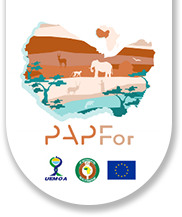Home / News / A capitalisation report on the PAPFor programme highlights an impressive (...)
A capitalisation report on the PAPFor programme highlights an impressive array of achievements, lessons learned and deliverables
PAPFor was implemented through seven programmes (six landscapes and one regional coordination) that had to adapt to different challenges (health, safety, socio-economic). They have all tested a range of practices, achieved diverse results and learned many lessons. They have also generated a body of information and products.
Just as the PAPFor programme and the PAPBio programme on savannah and mangrove ecosystems were about to come to an end, a new regional programme, NaturAfrica, was being set up, as explained later in this newsletter.
It was therefore particularly strategic to ensure that all the achievements and lessons learned from the PAPFor programme were documented and could be used to set up the new NaturAfrica programme.
It is with this objective in mind that the PAPFor Regional Coordination has commissioned a capitalisation project to document and enhance the achievements in terms of good practices, lessons learned and products resulting from the programme.
For each good practice or achievement of the PAPFor programme, lessons learned were identified. In some cases, lessons have been formulated in the form of recommendations concerning the difficulties, obstacles or major problems encountered in the field, whether or not they have been overcome.
A participatory and inclusive approach was adopted, with around twenty resource people consulted. A series of consultations was organised, with the support of the Regional Coordination, by videoconference with the implementing agencies, UEMOA, the DUEs, OBAPAO, BIOPAMA and other stakeholders.
The ‘PAPFor Products’ targeted are many and varied. They include socio-economic studies, biological inventories, spatial studies, protected area development and management plans, land use plans, local development plans, strategic documents for cross-border collaboration, activity narrative reports, external or internal interim evaluations, etc.
Nearly 600 documents were collected, consulted, compiled, classified and summarised by component, result and theme of the PAPFor programme.
A large proportion of these products are already available on the PAPFor website: www.papfor.org and will eventually be completed and migrated to the OBAPAO site and other relevant hostings so that the primary targets, i.e. conservation practitioners, students and national and regional administrations, can benefit fully from them.

